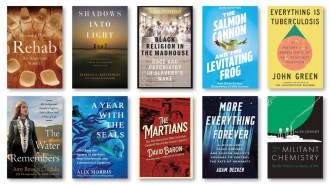Seeding liberal arts courses with science parables
- More than 2 years ago
As a graduate student, more than 50 years ago, I heard Isidor Rabi make a fervent appeal to cultivate common ground, shared by science and liberal arts. Ever since, in my own teaching, I’ve strived to do what he urged: “Scientists must learn to teach … in the light of the history of human thought and human effort, rather than as the geography of a universe uninhabited by mankind.”

This theme was admirably exemplified recently in science festivals held in Cambridge, Mass., (April 26–May 4) and in New York City (May 28–June 1), melding science with art, music, literature and drama, and in an elegant essay by Brian Greene (The New York Times, June 1). Here I make a kindred appeal.
A liberal arts education worthy of the tradition surely must aim to integrate some science into our general culture. But this will continue to be strongly inhibited unless faculty undertake some cross-fertilization. Scientists could contribute to humanities courses what I’ll call “seed parables,” stories that convey both a few basic facts and, more important, perspectives and modes of scientific thinking that transcend any particulars. Suitable materials for developing such parables are plentiful, especially among reports from Science News!
Here’s a sample parable: “Sex and the Single Methyl Group.” For its first few weeks in the womb, the sex of a human fetus cannot be distinguished, whether it has XX or XY chromosomes. During about the seventh week, a genetically programmed switch kicks in. For a normal XY fetus, some already developing female structures then fade away and male structures begin to form. In rare cases (about one per 50,000 to 100,000), however, the switch is defective; the XY fetus continues on to become a woman, with external anatomy correct in all respects, although she is infertile. (Some XY women may have been barred from the Olympics.) Magnetic resonance experiments have shown that one type of defect in the genetic switch, encoded by the Y chromosome, occurs at a critical location; it is a missing methyl group, just a carbon atom with three attached hydrogen atoms. If that single methyl group were missing much more often, human males might be as outnumbered as male bees or ants.
Do not frown or gloat! Human females would not be viable if certain genes were fully expressed on both X chromosomes. To avoid that, such genes on one or the other X chromosome are deactivated — by methyl groups attached at strategic locations. Moral: respect is due even a mere methyl group! This parable should seed lively discussion in a variety of humanities courses (including one at Harvard called “Manliness”).
Another sample: “Thomas Jefferson’s Plow.” Among the extraordinary range of his intellectual interests, Jefferson ranked science as his “supreme delight.” He especially esteemed Isaac Newton, studied avidly the Principia and mastered geometry and calculus. When he undertook to design an improved plow, a key issue was the optimum shape of the moldboard, the part that peels back and turns over the sod as the plow cuts through the soil. That posed a calculus problem; Jefferson solved it and his plow remained the standard for a century. (On principle, he did not take out a patent; otherwise he would have died rich rather than bankrupt.) Moral: A mathematical tool Newton invented to analyze orbits of heavenly bodies found countless other applications, including plowing earthly furrows. As well as enhancing history or political science courses, this parable might peel open stimulating vistas for calculus students.
Of course, scientists should invite humanists to reciprocate with parables or other kinds of seeds. Better still, students should be invited, whether in science or humanities courses, to undertake such culture-melding projects of their own designs. Exhibiting these in or outside class would amplify interest and learning via social interactions, emulating science-and-art festivals in an academic context.
That context is important to help students move beyond a “gee-whiz” impression of science. Genuine science literacy requires understanding how scientific knowledge is attained, its nature and limitations. Ironically, such large epistemological questions are seldom addressed in science courses. Those issues require the kind of probing discussions found in humanities courses.
A liberal arts education aims, above all, to instill the habit of self-generated questioning and thinking, of actively scrutinizing evidence. In pursuit of that aim, as urged by Rabi, the sciences and humanities should be complementary.
Human societies are linked by shared stories. Well-chosen parables ought to be among the provoking catalysts for a more inclusive academic culture.
Dudley Herschbach, winner of the 1986 Nobel Prize in chemistry, is Frank B. Baird, Jr. Professor of Science at Harvard University and is chairman of the Board of Trustees of the Society for Science & the Public.







